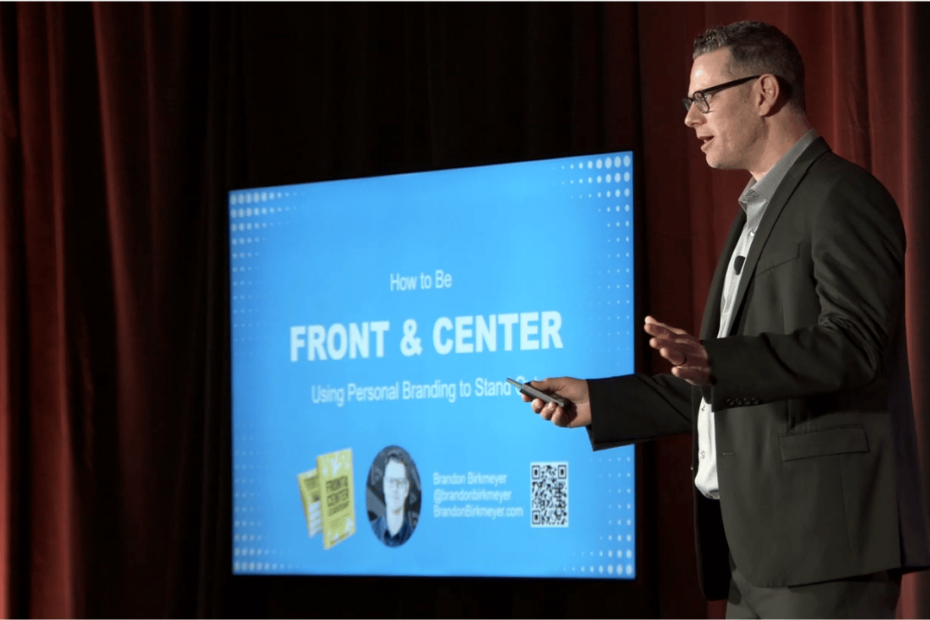This issue is presented by: The #1 Personal Branding Podcast … Brands On Brands with Brandon Birkmeyer
One of my last speaking engagements in 2024 was a 10-minute speaker showcase (watch it here). I felt the pressure of needing to make a first impression quickly. This wasn’t the first time I’ve felt that pressure. I feel it every time I go to an event where I’m meeting new people. I feel the same pressure on every new coaching call. First impressions matter. So how do we make sure we’re making a good first impression? We often hear that phrase… “make a good first impression,” but in a world where attention is scarce and opportunities are fleeting, simply being “good” isn’t enough. The key isn’t about being better than others—it’s about putting in the work to ensure you stand out and create an engaging, lasting impact. Whether you’re stepping onto a stage, walking into a networking event, or meeting a new client for the first time, preparation and practice are what elevate your presence. Here’s how you can take control of your first impression and make it work in your favor. (You can listen to the full podcast episode here)
Do Your Research: Set the Stage for SuccessBefore you ever walk into a room or step onto a stage, arm yourself with knowledge. Research the event, the audience, and the key people you may interact with. If you’re presenting, look at previous speakers, review videos of past events, and study what worked well and what didn’t. Understanding the setting, expectations, and dynamics of the room allows you to be intentional about your approach. For example, when I prepared for a speaker showcase, I watched recordings of previous presentations to assess the flow, speaker energy, and audience engagement. This allowed me to strategically plan how I would present myself to make an impact—choosing an engaging introduction, using confident body language, and ensuring my closing left a memorable impression.
Energy and Presence MatterHow you enter a room or step onto a stage immediately sets the tone. People are drawn to energy, enthusiasm, and confidence. Arrive with a smile, acknowledge those around you, and bring warmth into your interactions. A strong presence isn’t just about what you say; it’s about how you make people feel. When presenting, consider how you physically carry yourself. Open body language—such as an expansive posture and animated gestures—naturally draws people in. A well-paced, engaging voice helps maintain attention. Even in casual networking situations, standing with confidence, making eye contact, and showing genuine interest in others fosters meaningful connections. Craft an Engaging IntroductionIn any setting, your introduction should be clear, concise, and compelling. Avoid long-winded explanations and instead focus on what’s relevant to the audience. What do they need to know about you to understand your value? Keep it simple and impactful. For public speaking, ensure your introduction (especially if someone else is reading it) is short and dynamic. A well-crafted intro excites the audience and primes them for what’s to come, rather than losing their attention before you even begin.
Rehearse Until It Feels NaturalConfidence comes from practice. Whether you’re introducing yourself at a networking event, pitching a business idea, or giving a presentation, rehearsing helps ensure you communicate with clarity and ease. Record yourself, refine your delivery, and pay attention to your pacing and energy. When preparing for a high-stakes presentation, I rewrite and practice my opening multiple times to find the right flow and impact. The first 30 seconds determine whether people will stay engaged—so I make sure it’s strong. Engage Your Audience from Start to FinishA great first impression isn’t just about the beginning—it’s about sustaining engagement throughout the interaction. This means:
For speakers, a clear closing statement signals the end of your presentation and prompts the audience’s response, whether it’s applause, a discussion, or a follow-up action.
Stand Out Through Consistency and AuthenticityUltimately, standing out isn’t about competing with others—it’s about showing up fully prepared, bringing energy and authenticity, and making meaningful connections. People remember those who engage them, offer something of value, and leave them feeling inspired. So, before your next event or interaction, ask yourself: How can I prepare to be more present, engaging, and impactful? The effort you put in beforehand is what makes all the difference in the moment. Want to continue the conversation on personal branding and presence? Subscribe to my newsletter at brandsonbrands.com or connect with me on LinkedIn. I’d love to hear your thoughts! 😝Thanks for reading! Do you have any questions you’d like answered? Email me at brandon@brandsonbrands.com and let me know! Talk soon, Brandon Birkmeyer Personal Branding Coach, Bestselling author of Front & Center Leadership |






